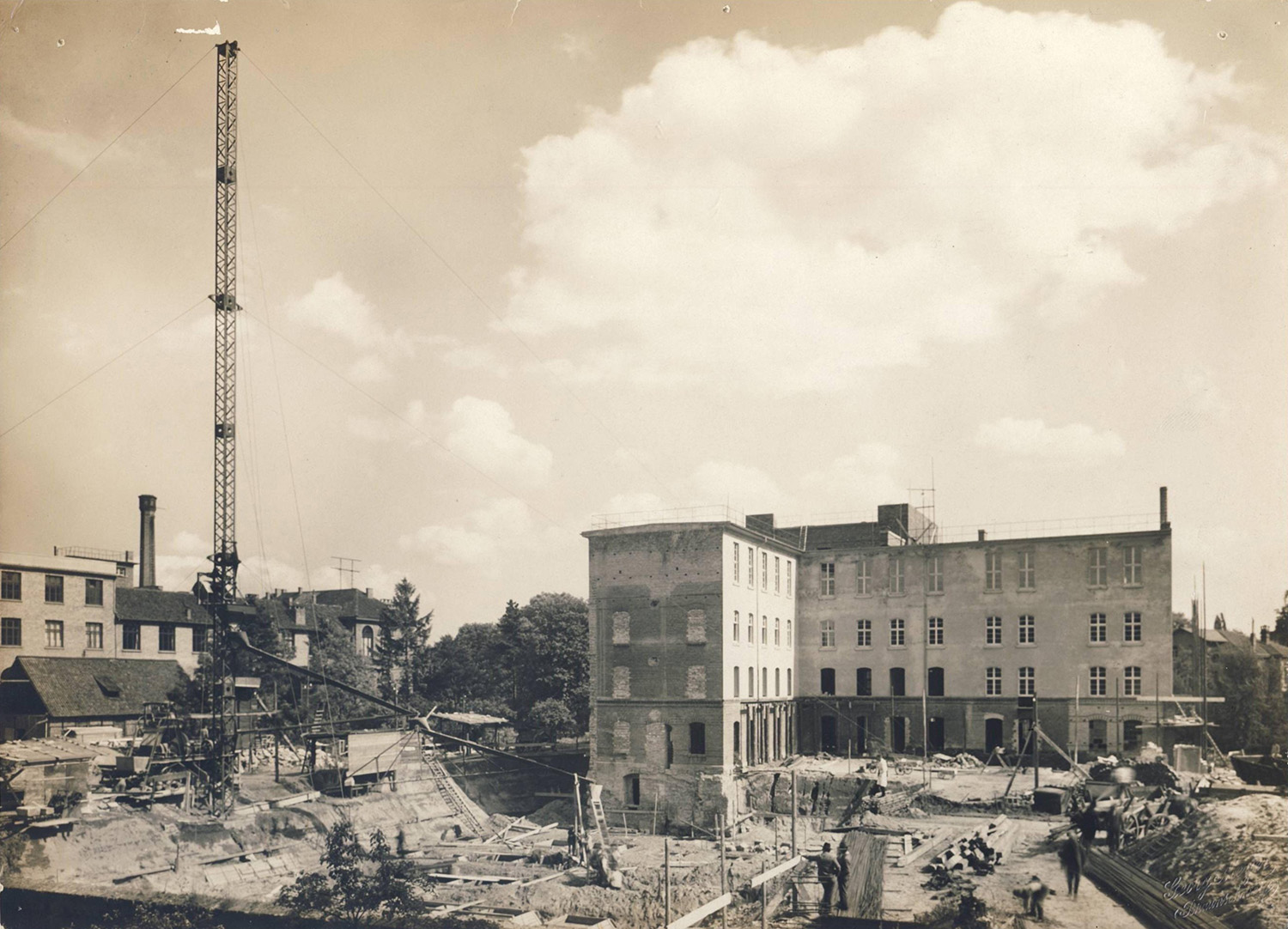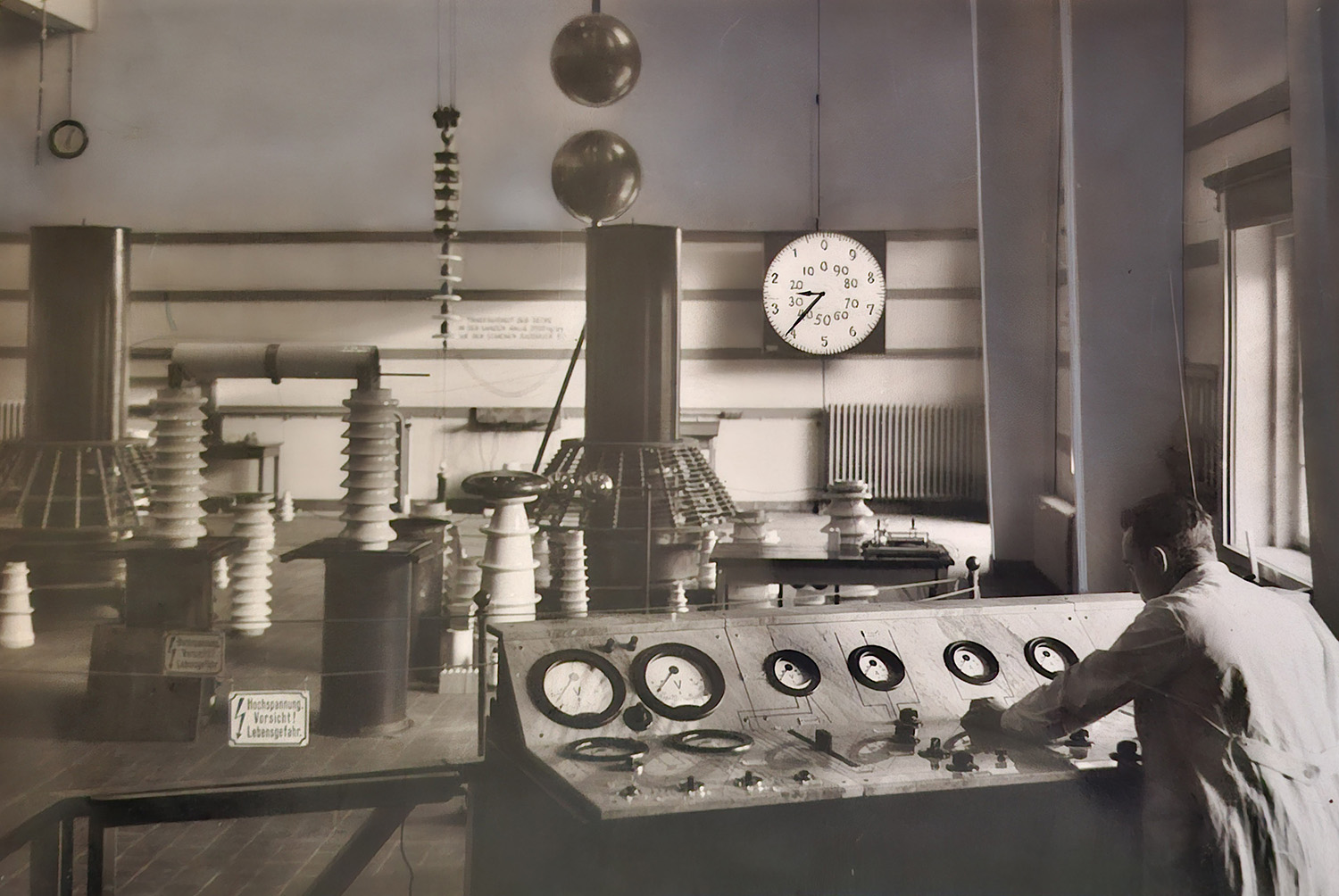100 years of the Institute for High Voltage Technology and Energy Systems On the anniversary: A brief look back at history
At the elenia Institute, scientists are tackling the technical and economic challenges of electrical energy supply. Current issues include the integration of renewable energies into the future energy supply system, the charging behaviour of electric vehicles and the analysis of switchgear. The history of research topics and the list of outstanding research personalities are long. On 1 and 2 October 2025, the institute will celebrate its anniversary with the ‘Festkolloquium elenia 100’ (elenia 100 anniversary colloquium). Professor Christian Kehrt looks back on a piece of scientific history.

Exterior view of the institute building in 1965. Photo credits: elenia Institute
The elenia Institute for High Voltage Engineering and Energy Systems looks back on a hundred years of history. Research and teaching priorities such as insulation testing, the development of switching and rectifier equipment, and high-voltage direct current transmission continue to shape the Braunschweig site to this day. The founding phase in the 1920s with Erwin Marx, who made the institute internationally known, was decisive.
The appointment of Erwin Marx
In 1925, Dresden engineer Erwin Marx (1893–1980) was appointed to the Chair of High Voltage Engineering. His invention of the Marx generator for producing surge voltages made it possible to reliably test the dielectric strength of insulating materials – a breakthrough for high voltage engineering. Marx came to Braunschweig even though the laboratories were still located in the basement of the main building and were poorly equipped. His appointment marked a decisive step towards the establishment of an independent electrical engineering department, separate from mechanical engineering. At the same time, his experimental teaching style attracted many young students and established a research tradition that combined practical laboratory work with theoretical training. His reputation among experts brought international attention to the university. Marx thus set the course for Braunschweig to develop into a centre for high-voltage technology.

Construction site of the new electrical engineering institute building, constructed on the basis of a modern reinforced concrete framework. Photo credits: elenia Institute
New building and a new beginning
Under Rector Carl Mühlenpfordt, the electrical engineering department was given a new institute building with modern laboratories, workshops and a 14-metre-high high-voltage hall. The opening in 1929 was celebrated in style, with lectures and spectacular experiments staged by Marx involving million-volt sparks.
Braunschweig thus rose to become a leading location for electrical engineering. The spacious facilities made it possible for the first time to conduct large-scale experiments under realistic conditions. The close connection between the university, the state government and funding associations showed how important electrical engineering was considered to be for industrial development. The new building thus symbolised not only a scientific but also a social new beginning.
Marx consistently pursued a visionary programme for high-voltage direct current transmission (HVDC). With the arc rectifier, he developed an alternative to mercury vapour rectifiers. The aim was to create a European HVDC network that would transmit cheap energy, for example from Norwegian hydropower, over long distances. His work was both basic research and applied technology development. The systematic investigation of voltage breakdowns and surge voltages was particularly important in order to ensure operational safety. Although the plans were ambitious, it took decades before they could be put into practice.
National Socialism and armaments research
Marx gained considerable importance in the Third Reich. He joined the NSDAP and SA, was responsible for 55 electrical engineering institutes in the Reich Research Council, and coordinated developments important for the war effort, such as radar equipment and detonators. The Nazi authorities supported him with considerable funds, as his research was considered central to their plans for self-sufficiency and rearmament. Marx used his position to establish networks between universities, industry and the Wehrmacht and to expand Braunschweig as a centre for high-voltage technology. His public loyalty to the regime, demonstrated through symbolic gestures such as presenting the institute with a picture of Hitler, also made him a visible figure in Nazi higher education policy. At the same time, his career exemplifies how technical expertise was used in the service of political power. Many of his projects were directly integrated into the military war economy and were of strategic importance.

Control panel with Tesla transformer, large test hall, 1929. Photo credits: elenia Institute
End of the war and a new beginning
Marx trained numerous students, including Adil Erk, who founded the Institute for Electrical Energy Systems in 1968, and Karl Brinkmann, who later held senior positions at Siemens. Important research facilities included the Hallendorf branch (1962–2007) with plasma physics and fusion research, as well as collaborations with the Physikalisch-Technische Bundesanstalt (PTB). Under Dieter Kind and his successors, research was refocused on plastic insulation, switch technology and electromagnetic compatibility. This shifted the institute’s focus from classic high-voltage technology to new areas of application. Close cooperation with industry and federal institutions guaranteed long-term financial and content stability. Many developments from this phase are still visible in energy supply practice today.
New priorities since 2000
Under Michael Kurrat and Bernd Engel, the institute focused on the challenges of the energy transition: grid expansion, electromobility and decentralised energy systems. The focus on sustainability led to new collaborations with politics, industry and municipal actors. At the same time, the number of employees and third-party funding grew considerably. The institute is thus positioning itself as an important player in the transformation of energy systems in the 21st century.
Author: Prof. Christian Kehrt, Department of History of Science and Technology, Institute of History, TU Braunschweig

